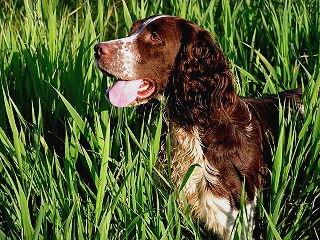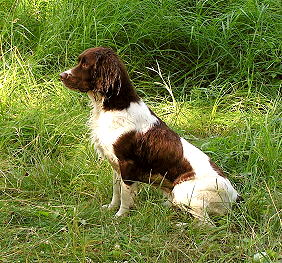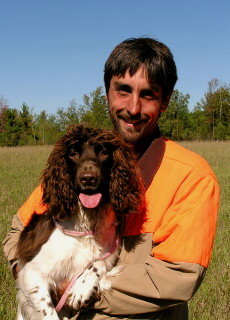 
Well, I thought this article would be devoted to different viewpoints based on the previous article about the use of electric collars. That wonít happen, as I got quite a lot of positive responses and no negative responses from the article. I had several folks who emailed after talking to their training groups - and there certainly are people who donít agree with my views. Folks seemed, however, to stick with the "if you donít have anything nice to say then donít say anything" rule. So, off we go onto different subjects. Since it is fall and various hunting seasons are upon us, the topic of hunting our competition dogs seems appropriate.
There are many versions of two basic opinions for this issue. Obviously, the two basic schools of thought are "Yes, hunt them" or "No, donít". I will start off by saying that I think the best thing you can do with a dog is to take it hunting. Sort of. I just donít look at it as "hunting" as much as I look at it as "training on wild game". I have heard several arguments for not hunting dogs, so I will address those opinions and interject my own thoughts regarding them. They are as follows:
Let us go through each of these arguments and sort out the truth from the old wives tales.
Number One
I absolutely agree that control may be lost if steps are not taken to maintain it. When hunting, one must always maintain an attitude of dog training first, killing birds second. If you are going hunting primarily to kill birds, then I donít think you should take your trial dog hunting. If you go hunting to give your dog work on wild birds, as well as to just spend more time with your dog and build your relationship with him, then you will be able to fully utilize your hunting experiences.
Let me give some examples. If I have a young trial dog that is very hard going, I will not run it through a creek bottom with cover over my head as I know I will lose control over the dog. He will break and chase birds all over. I might want that to happen with a softer dog in order to build confidence, but not for a real mover. Hunt the big runner in more open cover where he might have to go a ways between birds. If your dog breaks and chases off after the only rooster you saw all day, start yelling and screaming at your dog to get him sitting down, but donít even think about shooting that bird.
"If you go hunting to give your dog work on wild birds, as well as to just spend more time with your dog and build your relationship with him, then you will be able to fully utilize your hunting experiences."
I have found that hunting in areas where there are very high numbers of birds can calm down dogs ready to break and pump up dogs that need some fire. What happens is that you get lots and lots of flyaways. The on-the-edge dog soon learns there is no need to chase as there will be more birds soon enough. Imagine getting to practice calling your dog off fifty birds. Some of our Western states offer tons of hunting opportunities and while you will certainly find some roosters, you also get tons of bird work practice on all of the hens. It can really do wonders.
Number Two
This also has some truth behind it. I have not seen a slow flush created by wild birds, though I have seen it created a lot by game farm birds. Many eastern game farms have heavy, thick cover where birds can really bury themselves in. This slow flush can become really pronounced when the birds in question are chukar and quail. When hunting these sorts of places, I think it is important to go late in the year when the green grass is gone and scenting is good. Hunt for leftover birds in the cattail marshes - that can be fun! Try to find clubs having strong birds that more closely resemble their wild counterparts. If you are in cover and are noticing your dog slowing up on flushes, donít hunt there anymore. (That is sort of like your doctor telling you not to cough after you just told him it hurts when you cough!)
Use common sense, and your dog should be okay.
Number Three
It just seems pretty silly to me. If your dog has so little desire to hunt that it stops hunting when it doesnít find a bird in fifteen minutes, you should have him fixed, put him in a pet home, and get another puppy.
Speed can be affected by hunting, and I do wonder if that is the real reason for this argument. I have found that my dogs tend to have two speeds - a trial speed and a hunting speed. We teach them to sprint for the trials, but that isnít what you want for hunting. I like to hunt two at a time, heeling one while hunting another. When the first one starts getting tired, it can heel up and the second one can hunt. Most of my dogs get a second wind after their initial sprint and, after that, can go for hours at a slightly reduced pace.
Make sure you bring plenty of water in warmer weather hunts, and you should be fine. I have yet to get to a trial after hunting and think that my dogs are running too slow after all their work.
Number Four
This is a sort of good one. Dogs are likely to get injured when they are working. A dog that never leaves your kennel other than to run in a sterile field groomed for field trials is far less likely to get injured than a dog that sees a lot of hunting action. Eyes can get poked, limbs twisted and punctured, skin torn on wire and branches, and a mouthful of porcupine quills is never any fun to deal with. Also, cuts on crusty snow and large predators can occasionally come into play.
Itís a jungle out there.
But I have my dogs specifically to hunt them. That is what they were born and bred to do, and nothing in the world makes them happier. I do my best to keep them from coming to harm, but I believe there is too much to be gained by hunting to allow the risks to stop that from happening.
So, "what are the benefits?" you may ask. Nothing beats the sheer quantity of birds that can be found in some of the Western states. Last December, in North Dakota, I had a couple of young dogs that flushed over fifty birds a day... for a week. This experience helped them learn how to trail, how to keep their head in stressful situations, and how to work with me. I couldnít have set that up in training without emptying my bird pen. While that might actually be pretty fun, I donít think clients would be happy to see their bird bill for that month!
Iíve done a bit of ruffed grouse hunting with the dogs and have had interesting results with that. For me, it has been a learning experience - learning about the dogs. Most of my trial dogs hunted very well in the woods, sticking close in the leafy September trees. A few of them absolutely would not hunt close in this situation. I really didnít like that, and it certainly gave me more information about them when it comes time to consider them for breeding. From a breeding standpoint, I always feel that the more information I have about a dog the better. I like to find all of those negatives before a breeding is considered as that can help to produce puppies that the average hunting home will enjoy.
I will frequently work dogs at public hunting areas here, in Wisconsin. We shoot some ducks but very few pheasants. The best part is that I get to spend more time with the dogs. Some of the maniac trial dogs get to learn that there isnít a bird around every bush and they have to work for them, sometimes. Patience and teamwork is being taught. And really, for me, nothing is cooler then watching the sun disappear below the horizon, backlighting the red and orange fall leaves on the trees while a couple of spaniels sit next to me.
On that note, donít forget the liver treats, and I have a trial to get to.
Jason

|
|
|
| Bookstore | The Bookshelf | Advertise on SJ | Classifieds | Resources | NEW! Events | Letters | Archives | Spaniel Journal | |


